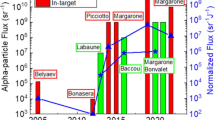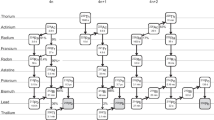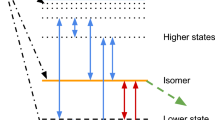Abstract
An extremely low-lying nuclear isomer in 229Th is still to be established in spite of efforts made since the first postulation of the isomer in 1976. To study such an extremely low-lying nuclear isomer, we have built an entirely new device that is based on the well-established atomic spectroscopic technique: Hollow-cathode discharge. The isomer in question is expected to be populated by the process NEET through atomic excited states if it exists in an energy range of electron volt. After switching off the discharge, we will measure alphas from the isomer, photons from the isomer itself and photons from atomic states to which the isomer is expected to decay by the inverse NEET. Our experiment is under way at Oarai using the world's radiochemically purest 229Th sample.
Similar content being viewed by others
References
Kroger L. A. and Reich C. W., Nucl. Phys. A 259 (1976), 29.
Helmer R. G. and Reich C. W., Phys. Rev. C 49 (1994), 1845.
Burke R. G., Garret P. E., Tao Qu and Naumann R. A., Phys. Rev. C 42 (1990), R499.
Irwin G. M. and Kim K. H., Phys, Rev. Lett. 79 (1997), 990.
Richardson D. S., Denton D. M., Evans D. E., Griffith J. A. R. and Tungate G., Phys. Rev. Lett. 80 (1998), 3206.
Utter S. B., Beiersdorfer P., Barnes A., Loughheed R. W., Crepso López-Urrutia J. R., Becker J. A. and Weiss M. S., Phys. Rev. Lett. 82 (1999), 505
Shaw R. W., Young J. P., Cooper S. P. and Webb O. F., Phys. Rev. Lett. 82 (1999), 1109.
Browne E., Norman E. B., Canaan R. D., Glasgow D. C., Keller J. M. and Young J. P., Phys. Rev. C 62 014311, (2001).
Mitsugashira T., Hara H., Ohtsuki T., Yuki H., Takamiya K., Kasamatsu Y., Shinohara A., Kikunaga H., and Nakanishi, T. J., Radioanal. Nucl. Chem. 255 (2003), 63.
Barci V., Ardisson G., Brarci-Funel G., Weiss B., El Samad O. and Sheline R.K., Phys. Rev. C 68 034329, (2003).
Arcimowicz B., Chojnacki S. and Inamura T. T., Warsaw University Heavy Ion Laboratory Annual Report 2002 (2003) p. 43.
Morita M., Prog. Theor. Phys. 49 (1973), 1574.
Karpeshin F. F., Band I. M., Trzhaskovskaya M. B. and Listengarten M. A., Phys. Lett. B 372 (1996), 1.
Inamura T. T., Karpeshin F. F. and Trzhaskovskaya M. B., Czech. J. Phys. 53 (2003), B349.
Karpeshin F. F., Band I. M. and Trzhaskovskaya M. B., Nucl. Phys. A 654 (1999), 579.
Karpeshin F. F., Band I. M., Trzhaskovskaya M. B. and Pastor A., Phys. Rev. Lett. 83 (1999), 1072.
Valero F. P. J., J. Opt. Soc. Am. 58 (1968), 484; 58 (1968), 1048.
H. Kikunaga, Doctoral thesis at Kanazawa University, to be published.
Author information
Authors and Affiliations
Consortia
Corresponding author
Rights and permissions
About this article
Cite this article
Inamura, T.T., Mitsugashira, T. & THE Oarai Collaboration. Pumping 229mTh by Hollow-Cathode Discharge. Hyperfine Interact 162, 115–123 (2005). https://doi.org/10.1007/s10751-005-9215-z
Published:
Issue Date:
DOI: https://doi.org/10.1007/s10751-005-9215-z




